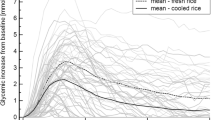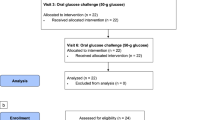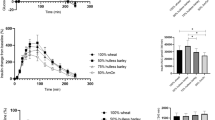Abstract
Background/Objectives:
A high prevalence of Type 2 diabetes exists in Saudi Arabia. Epidemiological evidence suggests that low glycaemic index (GI) diets reduce diabetes risk. Yet, little is known about the GI of traditional Saudi Arabian staples such as Hassawi rice (HR). HR was evaluated in terms of its GI and insulinaemic index (II). Comparisons were made in vitro assessing glucose released enzymatically. A long-grain rice variety available in both United Kingdom and Saudi Arabia was studied as a comparison.
Subjects/Methods:
For GI and II measurements, HR, Uncle Ben's rice (UBR) and a standard glucose solution were consumed by healthy subjects (n=13) on seven randomised occasions. Capillary bloods were collected at specific times over 2 h after food intake. Food and Agriculture Organization/World Health Organization protocols were used to determine GI and II. For the in vitro studies, cooked rice was incubated with hydrolytic enzymes under standardised conditions. Samples were taken at t=20 and t=120 min and rapidly available glucose (RAG) and slowly available glucose (SAG) were computed.
Results:
Values of RAG and SAG were lower for HR compared with their respective values for UBR (P<0.001 and P=0.011, respectively). However, no significant difference was observed for GI (P>0.05) despite a lower insulin response noted for HR (P=0.007).
Conclusions:
HR had a similar GI to UBR, although a lower insulin response was evident. RAG and SAG values were different for the two rice varieties despite similar GI values. These differences may be important in terms of their metabolic impact and outcome on diabetes.
This is a preview of subscription content, access via your institution
Access options
Subscribe to this journal
Receive 12 print issues and online access
$259.00 per year
only $21.58 per issue
Buy this article
- Purchase on Springer Link
- Instant access to full article PDF
Prices may be subject to local taxes which are calculated during checkout



Similar content being viewed by others
References
Al-Bahrany AM (2002). Chemical composition and fatty acid analysis of Saudi Hassawi Rice Oryza sativa L. Pakistan J of Biol Sci 5, 212–214.
Alissa EM, Bahijri SM, Ferns GA (2005). Dietary macronutrient intake of Saudi males and its relationship to classical coronary risk factors. Saudi Med J 26, 201–207.
Al-Mssallem IS, Al-Mssallem MQ (1997). Study of glutelin storage proteins in AI-Hassawi Rice (Oryza sativa). Arab Gulf J Sci Res 15, 633–646.
Al-Mssallem MQ (1999). Storage protein in Al-Hassawi rice. MSc Thesis. King Faisal University, College of Food & Agricultural Sciences, Al-Hassa, Saudi Arabia.
Al-Nozha MM, Al-Maatouq MA, Al-Mazrou YY, Al-Harthi SS, Arafah MR, Khalil MZ et al. (2004). Diabetes mellitus in Saudi Arabia. Saudi Med J 25, 1603–1610.
Association of Official Analytical Chemists (1995). Official Methods of Analysis, 16th edn. AOAC: Washington, DC.
Brand-Miller J, Pang E, Bramall L (1992). Rice: a high or low glycemic index food. Am J Clin Nutr 56, 1034–1036.
Brand-Miller J, Wolever TM, Foster-Powell K, Colagiuri S (2007). The New Glucose Revolution, 3rd edn. Hodder & Stoughton: London, UK.
Chinese Agricultural Technical Mission (CATM) (1985). Rice Production and Improvement. Annual report of Agricultural Cooperation agreement between the Kingdom of Saudi Arabia and the Republic of China. Hofuf Regional Agricultural Research Center: Hofuf, Al-Hassa, Saudi Arabia.
El-Hazmi MA, Warsy AS (1989). A comparative study of hyperglycaemia in different regions of Saudi Arabia. Ann Saudi Med 9, 435–438.
El-Hazmi MA, Warsy AS, Al-Swailem AM, Sulaimani R, Al-Meshari A (1998). Diabetes mellitus and impaired glucose tolerance in Saudi Arabia. Ann Saudi Med 4, 381–385.
Englyst HN, Kingman SM, Cummings JH (1992). Classification and measurement of nutritionally important starch fractions. Eur J Clin Nutr 46, S33–S50.
Englyst HN, Veenstra J, Hudson GJ (1996). Measurement of rapidly available glucose (RAG) in plant foods: a potential in vivo predictor of the glycaemic response. Br J Nutr 75, 327–337.
Englyst KN, Englyst HN, Hudson GJ, Cole TJ, Cummings JH (1999). Rapidly available glucose in foods: an in vitro measurement that reflects the glycemic response. Am J Clin Nutr 69, 448–454.
Englyst KN, Hudson GJ, Englyst HN (2000). Starch analysis in food. In: Meyers RA (ed.) Encyclopaedia of Analytical Chemistry. Wiley & Sons: Chichester, UK. pp 4246–4262.
Englyst KN, Vinoy S, Englyst HN, Lang V (2003). Glycaemic index of cereal products explained by their content of rapidly and slowly available glucose. Br J Nutr; 89, 329–340.
FAO/WHO (1998). Carbohydrates in human nutrition. Report of a Joint FAO/WHO Expert Consultation, 14–18 April 1997, FAO Food and Nutrition Paper 66, 1–140.
Fatani HH, Mira SA, El-Zubier AG (1987). Prevalence of diabetes mellitus in rural Saudi Arabia. Diabet Care 10, 180–183.
Frost G, Dornhorst A (2000). The relevance of the glycaemic index to our understanding of dietary carbohydrates. Diabet Med 17, 336–345.
Foster-Powell K, Holt S, Brand-Miller J (2002). International table of glycemic index and glycemic load values. Am J Clin Nutr 76, 5–56.
Jenkins DJ, Axelsen M, Kendall CW, Augustin LS, Vuksan V, Smith U (2000). Dietary fibre, lente carbohydrates and insulin-resistant diseases. Br J Nutr 83, S157–S163.
Kalergis M, De Grandpre E, Andersons C (2005). The role of the glycemic index in the prevention and management of diabetes: A review and discussion. Can J Diabet 29, 27–38.
Larsen HN, Christensen C, Rasmussen OW, Tetens IH, Choudhury NH, Thilsted SH et al. (1996). Influence of parboiling and physicochemical characteristics of rice on the glycaemic index in non-insulin-dependent diabetic subjects. Eur J Clin Nutr 50, 22–27.
Larsen HN, Rasmussen OW, Rasmussen PH, Alstrup KK, Biswas SK, Tetens IH et al. (2000). Glycaemic index of parboiled rice depends on the severity of processing: study in type 2 diabetic subjects. Eur J Clin Nutr 54, 380–385.
Leena S, Punam M, Valerie M, Dee B, Tashmin K, Isabel D (2004). Validation of a food frequency questionnaire to assess macro- and micro-nutrient intake among South Asians in the United Kingdom. Eur J Nutr 43, 160–168.
Meyer KA, Kushi LH, Jacobs DR, Slavin JJ, Sellers TA, Folsom AR (2000). Carbohydrates, dietary fiber, and incident type 2 diabetes in older women. Am J Clin Nutr 71, 921–930.
Musaiger AO (1987). The state of food and nutrition in the Arabian Gulf countries. World Rev Nutr Diet 54, 105–173.
Miller JB, Pang E, Bramall L (1992). Rice: a high or low glycemic index food. Am J Clin Nutr 56, 1034–1036.
Panlasigui LN, Thompson LU, Juliano BO, Perez CM, Yiu SH, Greenberg GR (1991). Rice varieties with similar amylose content differ in starch digestibility and glycaemic response in humans. Am J Clin Nutr 54, 871–877.
Patindol JA, Guraya HS, Champagne ET, McClung AM (2010). Nutritionally important starch fractions of rice cultivars grown in Southern United States. J Food Sci 75, H137–H144.
Ranawana DV, Henry CJK, Lightowler HJ, Wang D (2009). Glycaemic index of some commercially available rice and rice products in Great Britain. Int J Food Sciences Nutr 60, 99–110.
Salmeron J, Ascherio A, Rimm EB, Colditz GA, Spieqelman D, Jenkins DJ et al. (1997). Dietary fiber, glycemic load, and risk of NIDDM in men. Diabet Care 20, 545–550.
Schulze MB, Liu SM, Rimm EB, Manson JE, Willett WC, Hu FB (2004). Glycemic index, glycemic load, and dietary fiber intake and incidence of type 2 diabetes in young and middle-aged women. Am J Clin Nutr 80, 348–356.
Stevens J, Ahn K, Juhaeri J, Houston D, Steffan L, Couper D (2002). Dietary fiber intake and glycemic index and incidence of diabetes in African-American and White Adults: the ERIC study. Diabet Care 25, 1715–1721.
Stevenson E, Williams C, Nute M, Humphrey L, Witard O (2008). Influence of the glycaemic index of an evening meal on substrate oxidation following breakfast and during exercise the next day in healthy women. Eur J Clin Nutr 62, 608–616.
Wang Y, Li J (2005). The plant architecture of rice (Oryza sativa). Plant Mol Biol 59, 75–84.
Wild S, Roglic G, Green A, Sicree R, King H (2004). Global prevalence of diabetes: estimates for the year 2000 and projections for 2030. Diabet Care 27, 1047–1053.
Wolever TM (2000). Dietary carbohydrates and insulin action in humans. Br J Nutr 83 (Suppl. 1), S97–S102.
Wolever TM, Jenkins DJ, Jenkins AL, Josse RG (1991). The glycemic index: methodology and clinical implications. Am J Clin Nutr 54, 846–854.
Wolever TM, Jenkins DJ, Josse RG, Wong GS, Lee R (1987). The glycemic index: similarity of values derived in insulin-dependent and non-insulin-dependent diabetic patients. J Am Coll Nutr 6, 295–305.
Wolever TM, Jenkins DJA, Kalmusky J, Jenkins A, Giordano C, Giudici S et al. (1986). Comparison of regular and parboiled rices: explanation of discrepancies between reported responses to rice. Nutr Res 6, 349–357.
Acknowledgements
This work was supported by a grant from the King Faisal University, Saudi Arabia. It formed part of the work towards a PhD for M Al-Mssallem. HR was a gift from Dr IS Al-Mssallem, University of King Faisal, Al-Hassa, Saudi Arabia. We also thank Dr Klaus Englyst for his advice in setting up the RAG and SAG method; and Professor Linda Morgan for her comments on the paper. Professor Gary Frost is supported by an NIHR senior investigator award and the Biological Research Centre at Imperial College Health Care Academy.
Author information
Authors and Affiliations
Corresponding author
Ethics declarations
Competing interests
The authors declare no conflict of interest.
Rights and permissions
About this article
Cite this article
Al-Mssallem, M., Hampton, S., Frost, G. et al. A study of Hassawi rice (Oryza sativa L.) in terms of its carbohydrate hydrolysis (in vitro) and glycaemic and insulinaemic indices (in vivo). Eur J Clin Nutr 65, 627–634 (2011). https://doi.org/10.1038/ejcn.2011.4
Received:
Revised:
Accepted:
Published:
Issue Date:
DOI: https://doi.org/10.1038/ejcn.2011.4
Keywords
This article is cited by
-
Production and antioxidant activity of secondary metabolites in Hassawi rice (Oryza sativa L.) cell suspension under salicylic acid, yeast extract, and pectin elicitation
In Vitro Cellular & Developmental Biology - Plant (2022)
-
A glycaemic index compendium of non-western foods
Nutrition & Diabetes (2021)
-
Mapping QTLs using a novel source of salinity tolerance from Hasawi and their interaction with environments in rice
Rice (2017)
-
New quantitative trait loci for enhancing adaptation to salinity in rice from Hasawi, a Saudi landrace into three African cultivars at the reproductive stage
Euphytica (2014)



